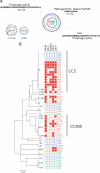Recent human-to-poultry host jump, adaptation, and pandemic spread of Staphylococcus aureus
- PMID: 19884497
- PMCID: PMC2780746
- DOI: 10.1073/pnas.0909285106
Recent human-to-poultry host jump, adaptation, and pandemic spread of Staphylococcus aureus
Abstract
The impact of globalization on the emergence and spread of pathogens is an important veterinary and public health issue. Staphylococcus aureus is a notorious human pathogen associated with serious nosocomial and community-acquired infections. In addition, S. aureus is a major cause of animal diseases including skeletal infections of poultry, which are a large economic burden on the global broiler chicken industry. Here, we provide evidence that the majority of S. aureus isolates from broiler chickens are the descendants of a single human-to-poultry host jump that occurred approximately 38 years ago (range, 30 to 63 years ago) by a subtype of the worldwide human ST5 clonal lineage unique to Poland. In contrast to human subtypes of the ST5 radiation, which demonstrate strong geographic clustering, the poultry ST5 clade was distributed in different continents, consistent with wide dissemination via the global poultry industry distribution network. The poultry ST5 clade has undergone genetic diversification from its human progenitor strain by acquisition of novel mobile genetic elements from an avian-specific accessory gene pool, and by the inactivation of several proteins important for human disease pathogenesis. These genetic events have resulted in enhanced resistance to killing by chicken heterophils, reflecting avian host-adaptive evolution. Taken together, we have determined the evolutionary history of a major new animal pathogen that has undergone rapid avian host adaptation and intercontinental dissemination. These data provide a new paradigm for the impact of human activities on the emergence of animal pathogens.
Conflict of interest statement
The authors declare no conflict of interest.
Figures



Similar articles
-
Human origin for avian pathogenic Staphylococcus aureus.Virulence. 2010 Jul-Aug;1(4):283-4. doi: 10.4161/viru.1.4.11838. Virulence. 2010. PMID: 21178455
-
Recombination-Mediated Host Adaptation by Avian Staphylococcus aureus.Genome Biol Evol. 2017 Apr 1;9(4):830-842. doi: 10.1093/gbe/evx037. Genome Biol Evol. 2017. PMID: 28338786 Free PMC article.
-
Evolutionary genomics of Staphylococcus aureus reveals insights into the origin and molecular basis of ruminant host adaptation.Genome Biol Evol. 2010 Jul 12;2:454-66. doi: 10.1093/gbe/evq031. Genome Biol Evol. 2010. PMID: 20624747 Free PMC article.
-
Staphylococcus aureus in veterinary medicine.Infect Genet Evol. 2014 Jan;21:602-15. doi: 10.1016/j.meegid.2013.08.011. Epub 2013 Aug 23. Infect Genet Evol. 2014. PMID: 23974078 Review.
-
The Staphylococcus aureus CC398 Lineage: An Evolution Driven by the Acquisition of Prophages and Other Mobile Genetic Elements.Genes (Basel). 2021 Oct 30;12(11):1752. doi: 10.3390/genes12111752. Genes (Basel). 2021. PMID: 34828356 Free PMC article. Review.
Cited by
-
Distribution of toxin genes among different spa types and phage types of animal Staphylococcus aureus.Arch Microbiol. 2015 Sep;197(7):935-40. doi: 10.1007/s00203-015-1127-y. Epub 2015 Jun 25. Arch Microbiol. 2015. PMID: 26108193 Free PMC article.
-
Identification of a highly transmissible animal-independent Staphylococcus aureus ST398 clone with distinct genomic and cell adhesion properties.mBio. 2012 Feb 28;3(2):e00027-12. doi: 10.1128/mBio.00027-12. Print 2012. mBio. 2012. PMID: 22375071 Free PMC article.
-
Mechanisms of host adaptation by bacterial pathogens.FEMS Microbiol Rev. 2024 Jun 20;48(4):fuae019. doi: 10.1093/femsre/fuae019. FEMS Microbiol Rev. 2024. PMID: 39003250 Free PMC article. Review.
-
The newest "omics"--metagenomics and metabolomics--enter the battle against the neglected tropical diseases.PLoS Negl Trop Dis. 2015 Feb 12;9(2):e0003382. doi: 10.1371/journal.pntd.0003382. eCollection 2015 Feb. PLoS Negl Trop Dis. 2015. PMID: 25675250 Free PMC article. No abstract available.
-
Genomic and functional determinants of host spectrum in Group B Streptococcus.PLoS Pathog. 2024 Aug 12;20(8):e1012400. doi: 10.1371/journal.ppat.1012400. eCollection 2024 Aug. PLoS Pathog. 2024. PMID: 39133742 Free PMC article.
References
-
- Nathanson N, Wilesmith J, Griot C. Bovine spongiform encephalopathy (BSE): Causes and consequences of a common source epidemic. Am J Epidemiol. 1997;145:959–969. - PubMed
-
- Ferguson NM, Donnelly CA, Anderson RM. The foot-and-mouth epidemic in Great Britain: Pattern of spread and impact of interventions. Science. 2001;292:1155–1160. - PubMed
-
- Boyd W, Watts M. Agro-industrial just-in-time: The chicken industry and postwar American capitalism. In: Goodman D, Watts M, editors. Globalising Food: Agrarian Questions and Global Restructuring. London: Routledge; 1997. pp. 192–225.
-
- Manning L, Baines RN. Globalisation: A study of the poultry-meat supply chain. Br Food J. 2004;106:819–836.
-
- Smyth JA, McNamee PT. Staphylococci, streptococci and enterococci, Poultry Diseases. In: Jordan F, Pattison M, Alexander D, Faragher T, editors. 6th Ed. Amsterdam: Elsevier; 2001. pp. 191–199.
Publication types
MeSH terms
Associated data
- Actions
- Actions
- Actions
- Actions
Grants and funding
LinkOut - more resources
Full Text Sources
Other Literature Sources
Medical
Molecular Biology Databases

